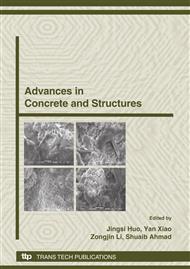p.281
p.287
p.295
p.301
p.311
p.321
p.329
p.335
p.341
Experimental Evaluation of Steel Beam Bolted to Reinforced Concrete Column Connections
Abstract:
In order to improve the constructability and meanwhile ensure excellent seismic behavior, an innovative bolted endplate connection to steel beam and reinforced concrete column (RCS) was developed, and three full scale model joints with or without floor slab were tested under simulated seismic loading. The proposed composite joint is characterized by an extended endplate which is welded to steel beam with reduced sections in factory and then bolted to reinforced concrete column using high-strength steel rods in field. The effect of material strength and concrete floor slab on the seismic behavior of joints was studied. Experimental results indicated that both specimens without floor slab exhibited good ductility and energy-dissipating ability with full plastic hinging formed at the reduced sections of steel beam. However, owing to the effect of floor slab, the beam sections became unsymmetrical and positive moment strength of the joint was increased significantly. The specimen with floor slab fractured at the weld between the bottom flange of the beam and the endplate, and the failure mode resembled what occurred during the Northridge earthquake.
Info:
Periodical:
Pages:
311-319
Citation:
Online since:
October 2008
Price:
Сopyright:
© 2009 Trans Tech Publications Ltd. All Rights Reserved
Share:
Citation:


